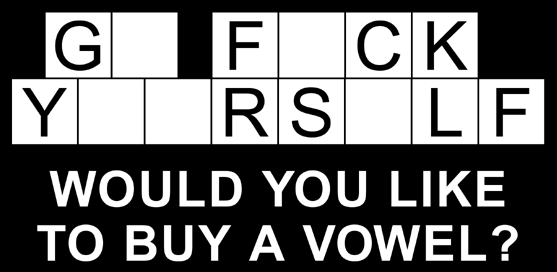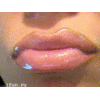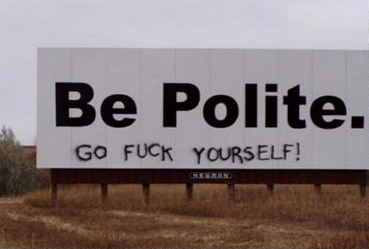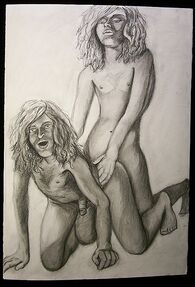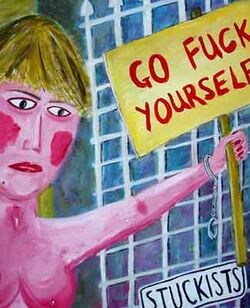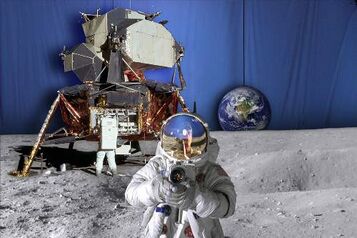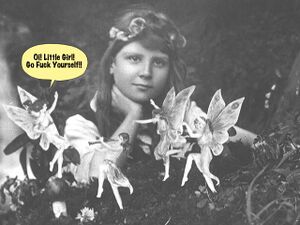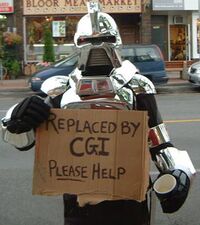Images
Images refers to visual artifacts, usually two-dimensional pictures, that either represent or duplicate the appearance of something real or imagined. Images are commonly used to document an actuality, tell a story, or communicate a message.
Image types[edit]
Letters of the alphabet[edit]
You are actually looking at images right now, produced by a simple word-processing application. Each letter in this sentence is an individual image, used to represent a letter of the alphabet. While the image of the letter "F" doesn't mean very much by itself, incorporating this image with other images of letters in the alphabet can yield words and then phrases such as "go fuck yourself". Using various word-processing techniques, this phrase can be given more visual assertiveness by using all capital letters (GO FUCK YOURSELF), making the font bold (GO FUCK YOURSELF) and making the text blink on and off ( GO FUCK YOURSELF ). This phrase can then be elevated to an even higher level if you make the font so large that it dwarfs all of the other words in an article, causing people to assume that this article is about
Rendered Images[edit]
Rendered images are created with computer applications that incorporate word-processing capabilities with image creation and pixel level editing.
Animated GIFs[edit]
Animated GIFs use magic to create an animation. Moving images are also capable of being manipulated by an image editor to create animations and loops of small clips.
Photos[edit]
A photograph is a powerful tool for conveying emotions and messages. Life's absurdities and special moments in time can now be easily captured with a digital camera and placed on the internet instantaneously.
Artistic representations[edit]
Paintings and carvings have been used by humans for thousands of years to create images that encompass a broad spectrum of expressions from Realism to Abstract.
Mental images[edit]
Mental images are pictures or actualities in everyday existence which haunt your mind for an extended period of time after viewing or experiencing them. They are easily generated by exposing yourself to particularly disturbing pictures which you continue to "see" in your mind well after their physical presence is eliminated. The continued exposure to phrases like "go fuck yourself" should also generate mental images of pictures you've seen on the internet which are too disgusting to display on a family oriented website like Uncyclopedia.
The Treachery of Images[edit]
In 1917, Long before the age of computers and digitally altered photographs, two English schoolgirls, 16-year-old Elsie Wright and her 10-year-old cousin Frances Griffiths, launched a deception that somehow managed to fool people into believing that Fairies existed, including the creator of Sherlock Holmes, Sir Arthur Conan Doyle. These two girls simply cut drawings of fairies out of magazines and books and posed with them in the garden. Despite being incredibly simplistic and low-tech, the "Cottingley Fairies Hoax" actually worked and it was years before anybody figured it out.
Ninety years later, people are still being fooled by the treachery of images. Is it any surprise that the English and their Fairy fetish can still be exploited with yet another set of fake images? In 2007, the "Derbyshire Fairy Hoax" was created by UK artist and magician Dan Baines who took a photograph of a model he created as an April Fool's Day prank - appearing to show the dessicated body of a dead fairy. Despite immediate public acknowledgment that the photographs and story had been faked, some people still refuse to believe it's not real and have even suggested a government conspiracy to cover-up the truth.
Of course, nothing can top the stupidity of the "intelligent design" addled Americans who still cling to the belief that the Apollo 11 astronauts actually landed on the Moon. Simply watch the film "Capricorn One", highlighted by OJ Simpson being hunted down and shot, and this shameful American pride tumbles to the ground like the World Trade Center.
CGI[edit]
Computer Generated Imagery or CGI has completely revolutionized the movie industry, exchanging advanced puppetry, animated models and actors in costumes with computer nerds and software. While CGI allows a character or creature to be rendered and included with live actors at a level that is unprecedented, the images are so clearly fake that it makes one falsely nostalgic for the days of men in really fake rubber suits pretending to be fucking giant monsters.

